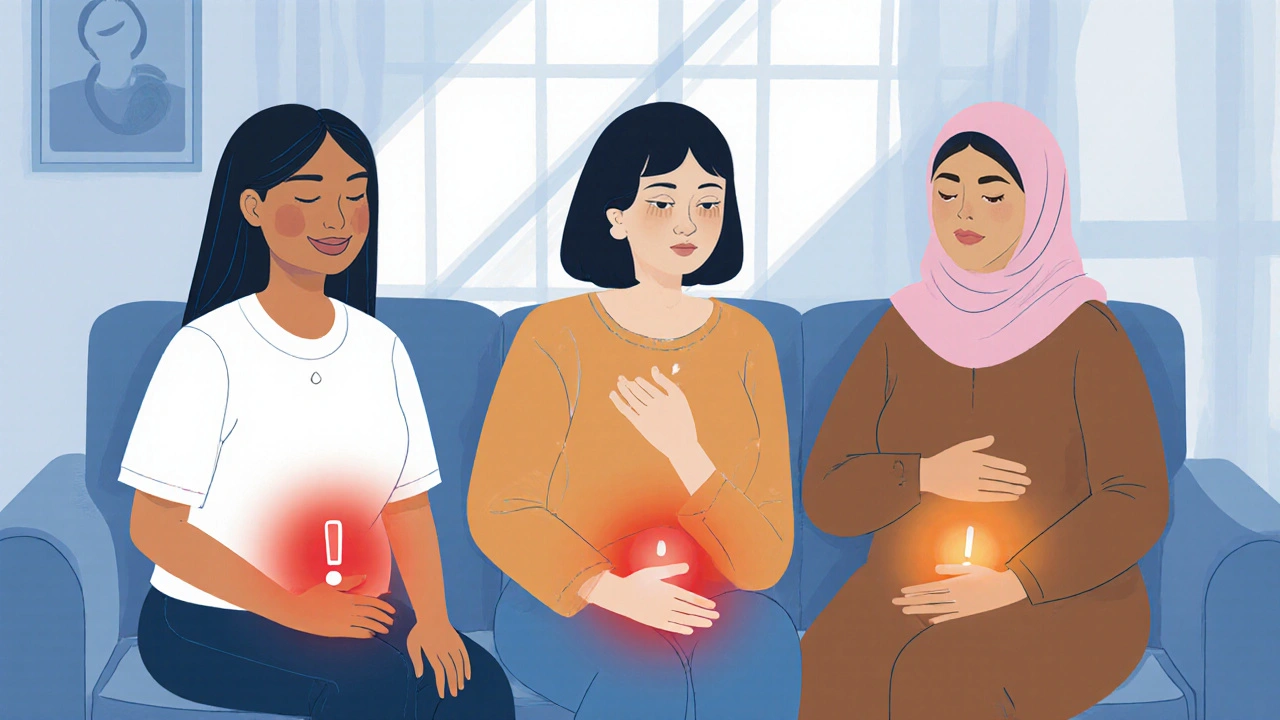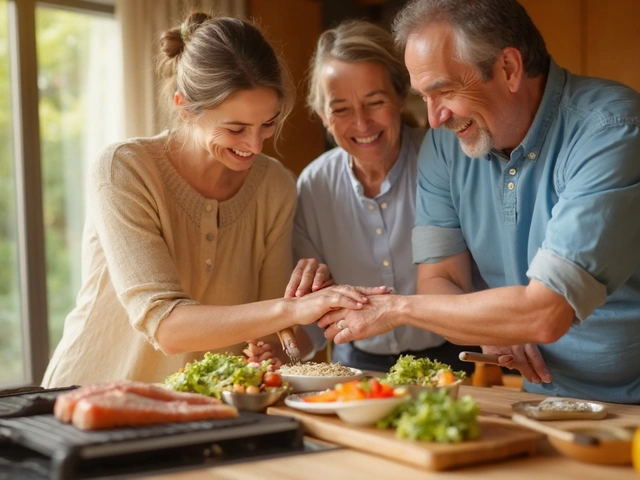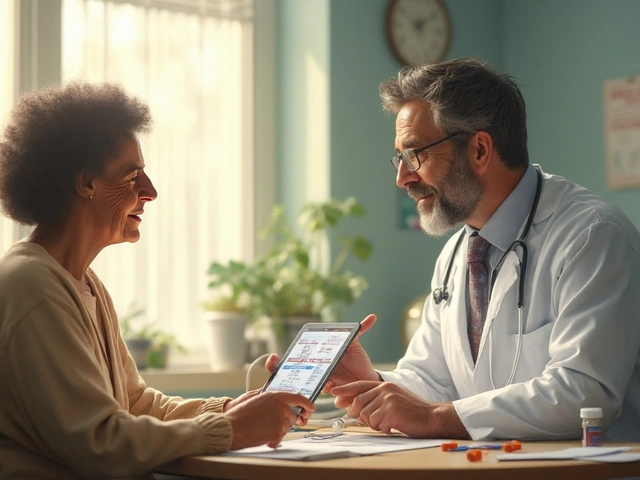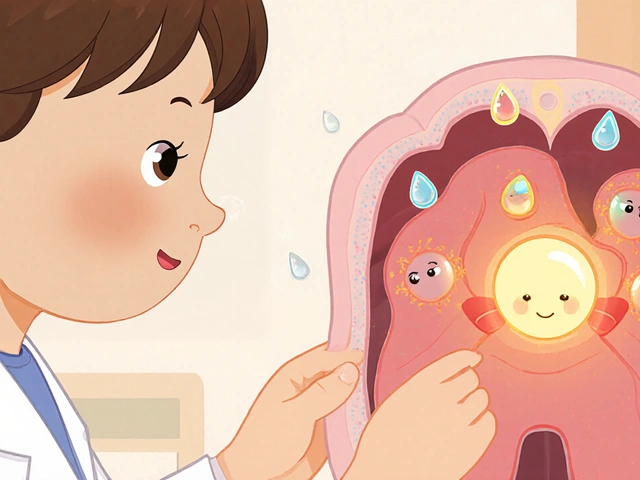Quick Take
- Typical cramps are short‑lived, start with your period, and improve with OTC painkillers.
- Endometriosis pain can begin days before bleeding, linger for weeks, and isn’t fully relieved by ibuprofen.
- Look for heavy periods, pain during sex, and chronic bowel or bladder issues - these are red flags.
- If you tick two or more red‑flag items, schedule a visit with a gynecologist.
- Early diagnosis often involves ultrasound, then laparoscopy if needed.
What Are Menstrual Cramps?
When you feel menstrual cramps are painful uterine contractions that happen just before or during your period, they’re usually linked to the hormone prostaglandin. Prostaglandin levels rise, the uterus contracts, and you get that familiar throbbing or cramping sensation in the lower abdomen.
Typical characteristics:
- Starts a day or two before bleeding and peaks during the first two days of flow.
- Lasts a few hours to a couple of days.
- Feels like a dull ache or tight band around the waist.
- Improves with heat, exercise, or over‑the‑counter NSAIDs (e.g., ibuprofen).
What Is Endometriosis?
Endometriosis is a chronic condition where tissue similar to the uterine lining grows outside the uterus. This ectopic tissue responds to the menstrual cycle just like normal endometrium-thickening, breaking down, and bleeding-except it has nowhere to exit the body.
The resulting inflammation can cause scar tissue (adhesions) and intense pain that often mimics regular cramps but has distinct patterns.
- Pain may begin a week or more before your period and persist for weeks after bleeding stops.
- It can be sharp, burning, or a deep ache that radiates to the lower back, hips, or thighs.
- Commonly accompanied by heavy or irregular periods, painful intercourse, and gastrointestinal or urinary symptoms.
- Typical pain relievers offer limited relief; hormonal therapy or surgical options are often needed.
Side‑by‑Side Comparison
| Feature | Typical Menstrual Cramps | Endometriosis‑Related Pain |
|---|---|---|
| Onset relative to period | 1‑2 days before bleeding | Up to 2 weeks before, may continue post‑period |
| Duration | Hours‑few days | Weeks‑months if untreated |
| Pain quality | Dull, cramping, band‑like | Sharp, burning, deep, radiating |
| Response to NSAIDs | Usually effective | Partial or minimal relief |
| Associated symptoms | Mostly menstrual flow | Heavy periods, dyspareunia, bowel/bladder pain, fatigue |
| Impact on daily life | Temporary discomfort | Chronic limitation, missed work/school |

Red Flags - When to Call a Gynecologist
If any of the following apply, it’s time to book an appointment:
- Pain that starts more than 48hours before your period.
- Severe pain that doesn’t improve with ibuprofen or heat.
- Bleeding that’s heavier than usual, lasts longer than 7days, or occurs between periods.
- Painful sex (dyspareunia) or pain during bowel movements.
- Unexplained fatigue, anemia, or infertility concerns.
These clues often point toward endometriosis symptoms that need professional evaluation.
Self‑Check Checklist
- Track your cycle on a calendar or app for at least three months.
- Note the exact day pain starts, intensity (1‑10 scale), and duration.
- Record any accompanying issues: heavy flow, pain after sex, bowel changes, or urinary urgency.
- Try a 48‑hour course of NSAIDs and heat; note how much relief you get.
- Compare your notes against the red‑flag list above.
- If two or more red flags appear, schedule a visit with a specialist.
- Ask about a pelvic ultrasound to rule out fibroids or ovarian cysts.
- If ultrasound is inconclusive, discuss referral for laparoscopy, the gold‑standard diagnostic tool for endometriosis.
Diagnosis & Treatment Overview
Diagnosing endometriosis often starts with a transvaginal ultrasound. While it can spot ovarian endometriomas, many peritoneal implants are invisible, so doctors may recommend a diagnostic laparoscopy. During this minimally invasive procedure, the surgeon can view, biopsy, and sometimes remove lesions.
Treatment paths vary:
- Hormonal therapy (combined oral contraceptives, progestins, GnRH agonists) aims to halt the menstrual cycle, reducing lesion growth.
- NSAIDs remain first‑line for pain but are often supplemented with hormonal options.
- Surgical excision or ablation can provide symptom relief, especially for deep infiltrating disease.
- Lifestyle tweaks-regular aerobic exercise, dietary anti‑inflammatory foods, and stress management-help many women manage flare‑ups.
Because endometriosis is chronic, a multidisciplinary approach (gynecologist, pain specialist, physiotherapist) yields the best outcomes.
Frequently Asked Questions
Can men experience endometriosis?
No. Endometriosis exclusively affects people with a uterus because the condition involves uterine‑like tissue growing elsewhere.
Is it normal to have painful periods at age 30?
Some discomfort is common, but if the pain is severe, lasts more than a few days, or interferes with daily life, it warrants a medical check‑up. Endometriosis often starts in the late 20s to early 30s.
Can endometriosis be cured?
There’s no permanent cure yet, but symptoms can be managed effectively with hormone therapy, surgery, and lifestyle changes. Many women achieve long‑term relief.
How long does it take to get a definitive diagnosis?
On average, it can take 5-10 years from first symptom to diagnosis, mainly because the pain is often dismissed as “bad periods.” Prompt evaluation and referral for laparoscopy can shorten this timeline.
Will endometriosis affect my fertility?
It can, especially if lesions involve the ovaries or fallopian tubes. However, many women with endometriosis conceive naturally; early treatment improves reproductive outcomes.






20 Comments
Hey folks, great breakdown here! If you’ve ever brushed off those gnawing pains as “just a bad period,” remember you deserve better care. Track your symptoms consistently and don’t hesitate to push for a second opinion when something feels off. Your body’s signals are powerful teachers, so listen and act on them.
We live in a world that normalizes women’s suffering, labeling relentless pelvic agony as “just hormonal drama.” Yet, when the pain eclipses everyday life, it becomes a moral failing of the medical system to dismiss it. Endometriosis isn’t a myth to be shrugged off; it’s a silent rebellion against our right to comfort. Let’s demand that every woman’s voice be heard, not silenced by lazy explanations. The stakes are real, the consequences profound.
The pathophysiology of ectopic endometrial implants involves cyclic hemorrhage, hemosiderin deposition, and peritoneal inflammation, which collectively generate a nociceptive cascade. In clinical parlance, we differentiate primary dysmenorrhea from secondary pain syndromes via temporal onset, analgesic responsiveness, and ancillary gastrointestinal manifestations. When NSAID efficacy wanes and dyschezia emerges pre‑menstrually, the differential should be broadened to include endometriosis. Imaging modalities such as transvaginal ultrasonography have limited sensitivity for peritoneal lesions, thus laparoscopy remains the gold standard for definitive diagnosis.
Honestly, the article nails it. Simple language, clear tables – you get the gist in minutes. If your cramps feel like a low‑grade ache that eases with ibuprofen, you’re probably fine. But when the pain feels like a burning ember that lingers for weeks, that’s a red flag. Don’t wait; book that appointment.
Super helpful guide! I always tell my friends to keep a symptom log – noting the day pain starts, intensity, and any side effects like bloating or fatigue. When you see patterns, it’s easier to discuss them with a doc and get the right tests. Remember, you’re not alone in this journey, and early action can make a big difference.
Reading through the checklist reminded me of the countless nights I spent wondering why my period pain never quite matched the “normal” description. I’d start feeling a dull pressure two weeks before my cycle, and it would stay with me like an unwanted guest, refusing to leave even after the bleeding stopped. Heat packs and ibuprofen were supposed to be my saviors, but they only offered a brief, superficial reprieve, like putting a bandage on a deep wound. Over time, the pain migrated – sometimes shooting down my thighs, other times nesting deep in my lower back, making every step feel like a negotiation with agony. I noticed that my libido took a nosedive, and intimacy became a chore rather than a pleasure, which added a layer of emotional strain I didn’t anticipate. My bathroom visits turned into strategic missions; I’d schedule them around work meetings because the urge to go was suddenly urgent and painful. I also began experiencing unexpected fatigue that no amount of coffee could chase away, and half the time I blamed it on a busy schedule instead of a hidden chronic condition. Keeping a simple spreadsheet seemed daunting at first, but once I logged each symptom, the pattern emerged unmistakably: more than two red‑flag items were ticking every month. I finally booked an appointment with a gynecologist, armed with my notes, and they didn’t need to ask many questions before ordering an ultrasound. The scan showed ovarian cysts that were later identified as endometriomas, confirming my suspicions. The doctor discussed laparoscopy as the next step, and while the idea of surgery was intimidating, I felt a surge of relief knowing I finally had a name for my pain. Post‑surgery, I was introduced to hormonal therapy, and gradually, the relentless pre‑period ache faded into a manageable background hum. Lifestyle tweaks, like incorporating yoga and anti‑inflammatory foods, also helped calm the flare‑ups. Looking back, the most powerful tool was simply paying attention and refusing to accept “it’s just my period” as an answer. If you’re reading this and see yourself in these stories, take a deep breath and start documenting – your future self will thank you.
These red‑flag signs are crystal clear, and it’s okay to set firm boundaries with your body and your doctor. When two or more indicators appear, schedule that visit without hesitation.
If it hurts for weeks, see a doc.
I love how the article breaks down the timeline of pain – it really helps to pinpoint whether something is just a cramp or something deeper. Adding a simple rating scale from 1 to 10 in your tracking can give your doctor a quick visual of severity trends.
While the checklist is useful, the article omits discussion of differential diagnoses like adenomyosis, which can mimic similar symptoms.
Great summary! As a women's health nurse, I always encourage patients to bring a written list of their symptoms to appointments. It makes the conversation more focused and less overwhelming for everyone involved.
It is imperative to recognize that the medical establishment has historically downplayed gynecological suffering, fostering a culture of silence that benefits none. One must therefore approach the diagnostic pathway with vigilance, questioning every dismissal and demanding comprehensive investigation, lest the insidious nature of endometriosis remain shrouded in bureaucratic inertia.
Imagine the uterus as a rebellious poet, spilling its verses beyond the pages it was meant to occupy – that’s endometriosis in vivid metaphor. The pain, then, isn’t merely physiological; it’s a languid sonnet of misplaced longing, echoing through hips and thighs, demanding attention.
Helpful guide – track dates note pain intensity compare with red flags – bring it to your doctor – clear next steps
When I first heard the term “endometriosis,” it sounded like a distant medical buzzword, not something that could hijack my everyday life. Yet the reality hit like a storm surge, overwhelming my body and spirit in equal measure. Each month felt like walking through a minefield, never knowing when the pain would flare or where it would strike next. I found solace in sharing stories with other women, realizing we were not isolated islands but a collective navigating the same turbulent seas. The article’s checklist felt like a lifeline, giving us a concrete way to articulate the chaos inside. Remember, the journey isn’t just about the physical symptoms; it’s about reclaiming your narrative from a condition that tries to define you. Keep speaking up, keep logging, and keep demanding the care you deserve.
Good info – concise and to the point.
The cultural stigma surrounding menstrual pain often obscures clinical realities, urging a more nuanced discourse that respects individual experiences while informing medical practice.
I've found that collaborating with a supportive friend to log symptoms makes the whole process less daunting and more accountable, especially when navigating appointments.
Hey all, just wanted to say this guide is spot on – keep an eye on those red flags and don’t delay getting help.
From a clinical perspective, the pathogenesis involves ectopic endometrial proliferation leading to neurovascular sensitization; thus, early laparoscopic intervention can preempt chronic nociceptive remodeling.